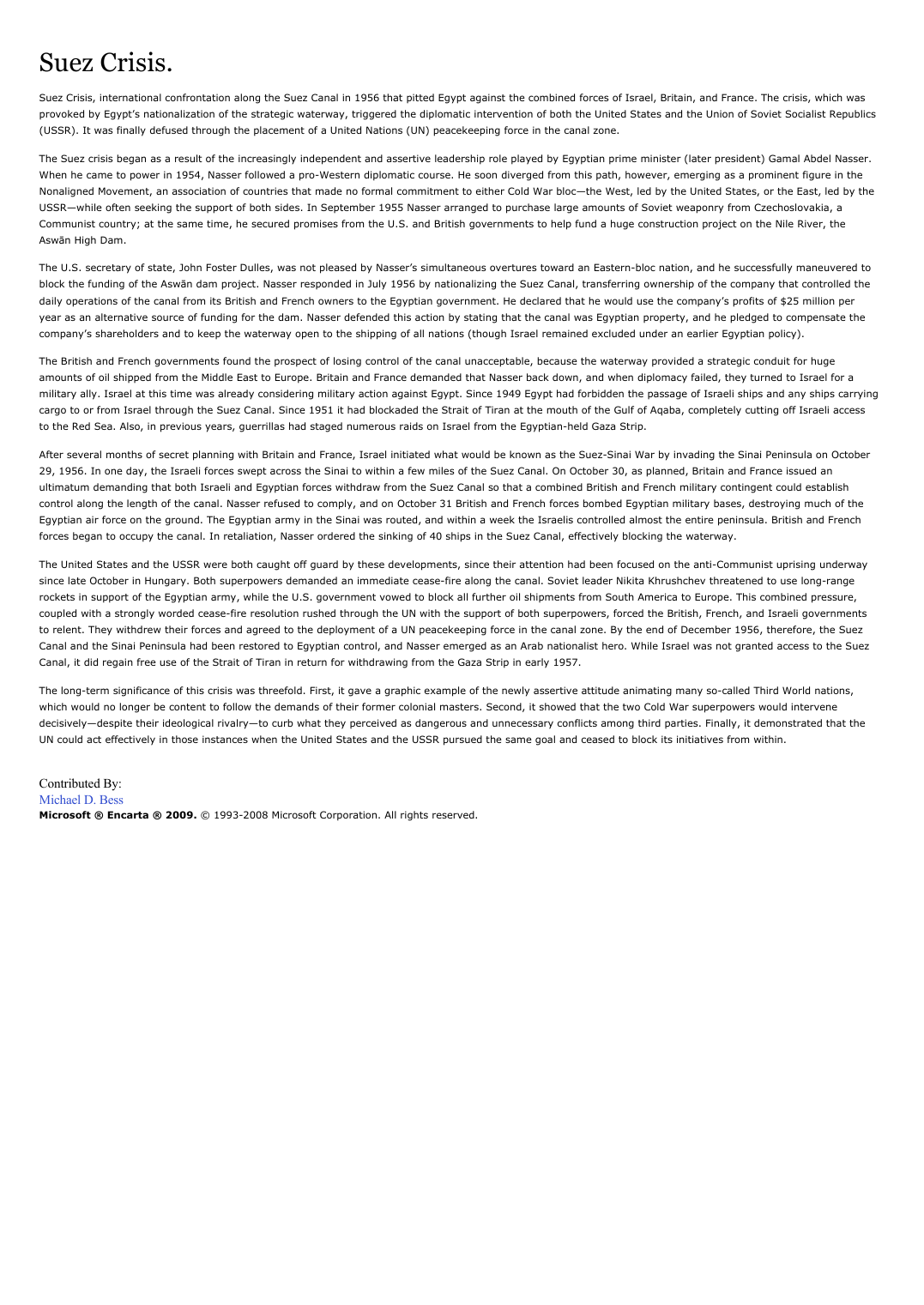Suez Crisis.
Publié le 18/05/2020

Extrait du document
«
Suez Crisis.
Suez Crisis , international confrontation along the Suez Canal in 1956 that pitted Egypt against the combined forces of Israel, Britain, and France.
The crisis, which was provoked by Egypt’s nationalization of the strategic waterway, triggered the diplomatic intervention of both the United States and the Union of Soviet Socialist Republics(USSR).
It was finally defused through the placement of a United Nations (UN) peacekeeping force in the canal zone.
The Suez crisis began as a result of the increasingly independent and assertive leadership role played by Egyptian prime minister (later president) Gamal Abdel Nasser.When he came to power in 1954, Nasser followed a pro-Western diplomatic course.
He soon diverged from this path, however, emerging as a prominent figure in theNonaligned Movement, an association of countries that made no formal commitment to either Cold War bloc—the West, led by the United States, or the East, led by theUSSR—while often seeking the support of both sides.
In September 1955 Nasser arranged to purchase large amounts of Soviet weaponry from Czechoslovakia, aCommunist country; at the same time, he secured promises from the U.S.
and British governments to help fund a huge construction project on the Nile River, theAswān High Dam.
The U.S.
secretary of state, John Foster Dulles, was not pleased by Nasser’s simultaneous overtures toward an Eastern-bloc nation, and he successfully maneuvered toblock the funding of the Asw ān dam project.
Nasser responded in July 1956 by nationalizing the Suez Canal, transferring ownership of the company that controlled thedaily operations of the canal from its British and French owners to the Egyptian government.
He declared that he would use the company’s profits of $25 million peryear as an alternative source of funding for the dam.
Nasser defended this action by stating that the canal was Egyptian property, and he pledged to compensate thecompany’s shareholders and to keep the waterway open to the shipping of all nations (though Israel remained excluded under an earlier Egyptian policy).
The British and French governments found the prospect of losing control of the canal unacceptable, because the waterway provided a strategic conduit for hugeamounts of oil shipped from the Middle East to Europe.
Britain and France demanded that Nasser back down, and when diplomacy failed, they turned to Israel for amilitary ally.
Israel at this time was already considering military action against Egypt.
Since 1949 Egypt had forbidden the passage of Israeli ships and any ships carryingcargo to or from Israel through the Suez Canal.
Since 1951 it had blockaded the Strait of Tiran at the mouth of the Gulf of Aqaba, completely cutting off Israeli accessto the Red Sea.
Also, in previous years, guerrillas had staged numerous raids on Israel from the Egyptian-held Gaza Strip.
After several months of secret planning with Britain and France, Israel initiated what would be known as the Suez-Sinai War by invading the Sinai Peninsula on October29, 1956.
In one day, the Israeli forces swept across the Sinai to within a few miles of the Suez Canal.
On October 30, as planned, Britain and France issued anultimatum demanding that both Israeli and Egyptian forces withdraw from the Suez Canal so that a combined British and French military contingent could establishcontrol along the length of the canal.
Nasser refused to comply, and on October 31 British and French forces bombed Egyptian military bases, destroying much of theEgyptian air force on the ground.
The Egyptian army in the Sinai was routed, and within a week the Israelis controlled almost the entire peninsula.
British and Frenchforces began to occupy the canal.
In retaliation, Nasser ordered the sinking of 40 ships in the Suez Canal, effectively blocking the waterway.
The United States and the USSR were both caught off guard by these developments, since their attention had been focused on the anti-Communist uprising underwaysince late October in Hungary.
Both superpowers demanded an immediate cease-fire along the canal.
Soviet leader Nikita Khrushchev threatened to use long-rangerockets in support of the Egyptian army, while the U.S.
government vowed to block all further oil shipments from South America to Europe.
This combined pressure,coupled with a strongly worded cease-fire resolution rushed through the UN with the support of both superpowers, forced the British, French, and Israeli governmentsto relent.
They withdrew their forces and agreed to the deployment of a UN peacekeeping force in the canal zone.
By the end of December 1956, therefore, the SuezCanal and the Sinai Peninsula had been restored to Egyptian control, and Nasser emerged as an Arab nationalist hero.
While Israel was not granted access to the SuezCanal, it did regain free use of the Strait of Tiran in return for withdrawing from the Gaza Strip in early 1957.
The long-term significance of this crisis was threefold.
First, it gave a graphic example of the newly assertive attitude animating many so-called Third World nations,which would no longer be content to follow the demands of their former colonial masters.
Second, it showed that the two Cold War superpowers would intervenedecisively—despite their ideological rivalry—to curb what they perceived as dangerous and unnecessary conflicts among third parties.
Finally, it demonstrated that theUN could act effectively in those instances when the United States and the USSR pursued the same goal and ceased to block its initiatives from within.
Contributed By:Michael D.
BessMicrosoft ® Encarta ® 2009. © 1993-2008 Microsoft Corporation.
All rights reserved..
»
↓↓↓ APERÇU DU DOCUMENT ↓↓↓
Liens utiles
- dnl vIETNAM wAr: Why was the Viet Nam war a major crisis of the Cold War?
- How Is Britain Dealing With Its Identity Crisis ?
- SUEZ
- Suez, canal de.
- A la suite de quel événement Nasser nationalisa-t-il lecanal de Suez en 1956:A.


